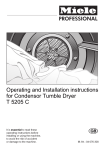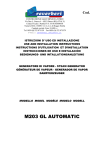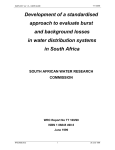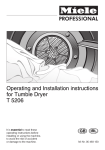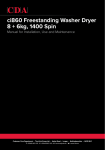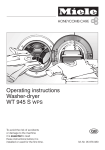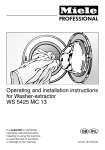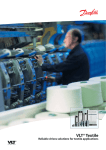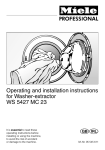Download Miele WS 5425 MC 13 Operating instructions
Transcript
Operating Instructions
for Washer-extractor
WS 5425 MC 7
It is essential to read these
operating instructions before
installing or using the machine,
to avoid the risk of accident
or damage to the machine.
Q
M.-Nr. 04 386 930
Contents
Page
Guide to the machine. . . . . . . . . . . . . . . . . . . . . . . . . . . . . . . . . . . . . . . . . . . . . . . 3
Use of the appliance . . . . . . . . . . . . . . . . . . . . . . . . . . . . . . . . . . . . . . . . . . . . . . . . 5
Warning and Safety Instructions . . . . . . . . . . . . . . . . . . . . . . . . . . . . . . . . . . . . . 6
Preparing for Use
Help to protect our environment . . . . . . . . . . . . . . . . . . . . . . . . . . . . . . . . . . . . . . . 9
Before using for the first time . . . . . . . . . . . . . . . . . . . . . . . . . . . . . . . . . . . . . . . . . 11
Operation
Washing environmentally and economically . . . . . . . . . . . . . . . . . . . . . . . . . . . . .
Preparing the wash load . . . . . . . . . . . . . . . . . . . . . . . . . . . . . . . . . . . . . . . . . . . .
Wash care symbols . . . . . . . . . . . . . . . . . . . . . . . . . . . . . . . . . . . . . . . . . . . . . . . .
Adding detergent . . . . . . . . . . . . . . . . . . . . . . . . . . . . . . . . . . . . . . . . . . . . . . . . . .
– fabric conditioner/starch . . . . . . . . . . . . . . . . . . . . . . . . . . . . . . . . . . . . . . . . . .
Selecting a programme . . . . . . . . . . . . . . . . . . . . . . . . . . . . . . . . . . . . . . . . . . . . .
– changing a programme sequence . . . . . . . . . . . . . . . . . . . . . . . . . . . . . . . . . .
– programmes. . . . . . . . . . . . . . . . . . . . . . . . . . . . . . . . . . . . . . . . . . . . . . . . . . . .
programme end . . . . . . . . . . . . . . . . . . . . . . . . . . . . . . . . . . . . . . . . . . . . . . . . . . .
10
12
13
14
15
16
19
21
24
Maintenance
Cleaning and care . . . . . . . . . . . . . . . . . . . . . . . . . . . . . . . . . . . . . . . . . . . . . . . . . 25
Problem solving guide . . . . . . . . . . . . . . . . . . . . . . . . . . . . . . . . . . . . . . . . . . . . . . 29
After sales service . . . . . . . . . . . . . . . . . . . . . . . . . . . . . . . . . . . . . . . . . . . . . . . . . 34
Installation and connection
Installation . . . . . . . . . . . . . . . . . . . . . . . . . . . . . . . . . . . . . . . . . . . . . . . . . . . . . . . 35
Electrical connection . . . . . . . . . . . . . . . . . . . . . . . . . . . . . . . . . . . . . . . . . . . . . . . 40
Plumbing . . . . . . . . . . . . . . . . . . . . . . . . . . . . . . . . . . . . . . . . . . . . . . . . . . . . . . . . 41
Technical data. . . . . . . . . . . . . . . . . . . . . . . . . . . . . . . . . . . . . . . . . . . . . . . . . . . . 44
2
Guide to the machine
1
2
3
4
Machine lid
Detergent dispenser / Control panel
Drum door
Access panel - drainage system
(and/or pump and filter),
emergency door opener
5 Height-adjustable feet
6 Cable entry for extra equipment
7 Inlet hose (cold water)
8 Inlet hose (hot water)
9 Transit fitting (remove before
commissioning)
10 Supply power cable
Drain pump or drain valv
(as ordered)
Drain hose (for drain pump)
11
12 Drain hose (for drain valve)
13 Height-adjustable feet
3
Guide to the machine
Pushbutton switches
a Door
Programme sequence indicator lights
I/h
On/Start
i
Pre-wash
j
Main wash
n
Rinse
Can be selected with programmes
A, B, C and E
n
Rinse
n
Rinse
h Start
q
Drain
Starts the programme
u
Final spin
opens the drum door, releases the
“with pre-wash” button if this was
pushed in.
+i With Pre-wash
r
End
Additional display and indicator lights
pq
Water inlet/Drain
(above the pushbutton switches)
Programmes
& °C Temperature
j min Time left
A
B
C
D
E
F
4
Cottons
Minimum iron
Delicates/Synthetics
Woollens
Short
Separate spin
Guide to the machine
Detergent dispener drawer
Control panel
Compartment i - for the pre-wash
A small panel is provided with the machine to explain the symbols on the
Compartment j - for the main wash
control panel. This is to be inserted into
the front of the detergent dispenser
Compartment p - (with extra lid), for
fabric conditioner or drawer.
liquid starch
formulation
Set the small panel into the lower
guide, press downwards and at the
same time slot it in at the top.
Use of the appliance
This automatic washing machine is
particularly suitable for use in communal laundry rooms, laundrettes etc.,
where considerable amounts of soiled
laundry occur.
5
Warning and Safety Instructions
Please read the operating instructions before using this machine for
the first time. They contain important information about the safety, use
and maintenance of the machine.
This will avoid the risk of accidents
and damage to the machine.
Keep these operating instructions in
a safe place and ensure that new
users are familiar with the content.
Pass them on any future owner of
the machine.
Correct usage
Only use the washer-extractor to
wash items which are declared by
the manufacturer to be machine-washable on the wash-care label.
Any other applications may be dangerous. The manufacturer is not liable
for damage resulting from improper
use or operation.
Do not let small children play with
the machine and its controls or
operate it. Please supervise its use by
the elderly or infirm.
Technical safety
Before setting up the machine
check it for any externally visible
damage.
Do not install or use a damaged machine.
6
Before connecting the machine, ensure that the connection data on
the data plate (fusing, voltage and frequency) matches the mains electricity
supply. If in any doubt, consult a qualified electrician.
The electrical safety of this machine can only be guaranteed
when continuity is complete between
the machine and an effective earthing
system which complies with local and
national regulations. It is most important that this basic safety requirement is
regularly tested by a qualified electrician.
The manufacturer can not be held responsible for the consequences of an
inadequate earthing system.
The machine is built in accordance
with current safety requirements.
Unauthorised repairs could result in unforeseen dangers for the user, for
which the manufacturer can not accept
responsibility. Repairs should only be
undertaken by a Miele approved engineer.
The machine is only completely isolated from the electricity supply
when:
– the plug is withdrawn, or:
– it is switched off at the mains, or
– the mains fuse is withdrawn.
Warning and Safety Instructions
The best materials are used in the
manufacture of this machine, and
every care is taken to check all parts.
However, with time, deterioration of
parts can occur, especially with such
components as hoses, giving rise to
leaks. This should be borne in mind if
operating the machine without supervision. Check the hose regularly for signs
of wear, and change in good time, to
avoid leaks and subsequent damage.
Faulty components must only be
exchanged for Miele original spare
parts. Only when these parts are fitted
can the safety standards of the machine be guaranteed.
Use
Do not install your washing machine in rooms where sub-zero
temperatures may occur. Frozen hoses
may burst under pressure. The reliability of the electronic control system
may be impaired at temperatures
below freezing point.
both the machine and adjacent furniture or appliances.
Turn off the stopcock if the machine will be left for any length of
time (e.g. holiday), especially if there is
no floor drain (gully) in the immediate
vacinity.
Flooding danger.
If hooking the drain hose into a
wash basin, check that the water can
drain off quickly enough to prevent the
sink from overflowing.
Make sure the drain hose is secure, so
that the force of the water flowing out of
the hose does not dislodge it. Otherwise this will result in flooding.
Take care to ensure that foreign objects (e.g. nails, needles, coins,
paper clips, etc.) do not find their way
into the machine with the washing (e.g.
in pockets). Foreign objects can damage components of the machine, which
in turn, can result in damage to the
washing.
In countries where there are areas
which may be subject to infestation by cockroaches or other vermin,
pay particular attention to keeping the
appliance and its surroundings in a
clean condition at all times. Any damage which may be caused by cockroaches or other vermin will not be
covered by the appliance guarantee.
Before using the machine for the
first time, check that the transit fitting at the rear of the machine has
been removed (see “Installation”). During spinning, a transit fitting which is
still in place may result in damage to
7
Warning and Safety Instructions
If the correct amount of detergent
is dispensed, the machine should
not need to be descaled. If however,
you do wish to descale the machine,
only use proprietary non-corrosive descaling agents and strictly observe the
instructions. Consult the Miele Customer Service Department.
Textiles which have been pretreated in detergents containing
solvents must be thoroughly rinsed in
clean water before being washed in the
machine.
Never use detergents containing
solvents in this machine, as this
may result in damage to component
parts and create toxic fumes. Such
detergents also pose a fire and explosion hazard.
Dye removers may contain sulphur
compounds which may damage
washing machines. Only use dyes or
dye removers specified by the manufacturer as being suitable for use in a
washing machine. Always observe the
manufacturer’s instructions carefully.
If washing at very high temperatures remember that the porthole
glass will be hot. Do not let children
touch it during a hot wash programme.
8
Always make sure the drum is stationary before reaching in to
remove washing. Reaching into a moving drum is extremely dangerous.
Accessories
Accessory parts may only be fitted
when expressly approved by
Miele. If other parts are used, guarantee, performance and product liability
claims may be invalidated.
Disposal of your old machine:
Before discarding an old machine
unplug it. Render the plug useless.
Cut off the cable directly behind the appliance to prevent misuse.
Help to protect our environment
Disposal of the packing material
Disposal of your old machine
The transport and protective packing
has been selected from materials which
are environmentally friendly for disposal
and can normally be recycled.
Old machines contain materials which
can be reclaimed or recycled. Please
contact your dealer, your local waste
collection centre or scrap merchant
about potential recycling schemes.
–
–
–
–
–
–
Corrugated paper / card
Polystyrene - CFC free
Polyethylene foil (transparent) PE
Fibre board - solvent free
Wood - untreated
Packaging straps: Polypropylene PP
Ensure that the machine presents no
danger to children while being stored
for disposal.
See the appropriate section in the
Warning and Safety instructions.
Rather than just throwing these materials away, please ensure they are
offered for recycling.
9
Washing environmentally and economically
Washing environmentally
Economy tips
Caring for the environment means saving water, energy and detergent when
washing. This machine is equipped
with the Hydromatic System and Miele
“wash system” with ball valve. These
systems contain a variety of technical
features, such as the drum ribs, which
are designed to enable economical
washing without compromising on
results.
To help you wash most economically,
remember the following tips:
The automatic load control facility enables loads of between 1 and 5 kg to
be washed using only as much water
and electricity as is required for an effective wash.
Spinning at the high speed of 1200
rpm reduces drying times and energy
consumption if laundry is dried in a
tumble dryer after washing.
10
Always wash with the maximum
laundry load specified for each programme. This uses the energy to the
best advantage.
Only use the correct amount of detergent required for the water hardness
level in your area, as recommended
by the manufacturer.
If laundry is not heavily soiled, select
a lower temperature setting than indicated on the laundry care label.
Use the SHORT programme for
laundry that just needs freshening
up, or is only very lightly soiled.
Before using for the first time
Important: the appliance must be
properly installed and connected to
the water and electricity supply according to local and national regulations.
Check that the transit fitting at the
rear has been removed.
Water hardness reminder
The amount of detergent will depend
on various factors including water hardness. Your local water authority can advise on water hardness in your area.
For further information read the instructions on pages 35-43.
Washing out the machine
Any residual lubricants and water from
testing still in the machine should be
flushed out as follows:
Do not load any laundry in the machine.
Add a little detergent to compartment j.
Turn the programme selector switch
to the “A” Cottons 60°C programme.
Press the Start h button.
The dial in the detergent box can be
set as a water hardness reminder (1-4,
see Chart p.14). Use the spatula (supplied for opening the drain filter panel).
11
Preparing the wash load
being suitable for machine washing on
the textile care label.
Pre-treating the washing
Badly soiled areas, e.g. collars and
cuffs, and water soluble stains, can be
pre-treated with bar soap, liquid detergent or detergent mixed into a solution
or paste.
With particularly stubborn stains ask
your Dry Cleaner for advice.
Do not use detergents containing solvents in this machine.
Empty all pockets.
Loading the drum
Foreign objects (e.g. nails, coins,
paper clips etc.) can cause damage to textiles and components in
the machine.
Most garments have a textile care label
in the collar or side seam. Sort the
laundry by care label symbols.
Unfold laundry and load loosely in the
drum. To achieve best results it is advisable to make up mixed loads consisting of both large and small items. This
improves the washing effect and helps
distribute the load evenly to keep the
machine stable and reduce the noise
level during spinning. Overloading reduces the wash result and causes
more creasing.
Only wash items in this machine which
are declared by the manufacturer as
being machine washable on the textile
care label.
It is advisable to weigh the load first to
make best use of the machine’s capacity. (See pp. 21-23 for max. suggested
loads).
Dark textiles often contain excess dye,
and should be washed separately several times before being included in a
mixed load.
With curtains: Remove lead weights
and strips or place in a laundry bag.
Sort the laundry
Delicate textiles should be washed separately in a delicates programme.
Only wash textiles made from wool or
wool mixtures if they are declared as
12
Woollens and knitted garments should
be turned inside out if the manufacturer
recommends it.
Close the drum door
Make sure that there is no obstruction
between the drum door and seal.
Textile care symbols
Washing
987 Cottons
54321 Minimum iron
21 Delicates/Synthetics
a@ Machine washable
Woollens
/
Hand wash
h do not wash
ABC dry clean
D
y
z
do not dry clean
suitable for chlorine bleaching
not suitable for chlorin
bleaching
The significance of the bar beneath the
wash tub:
e
no bar,
normal (maximum) agitation, eg Cottons programme
f
bar,
reduced overall action, eg Minimum
iron and Delicates programme
g
broken bar,
much reduced (minimum) agitation,
Woollens programme
Tumble dry
q
r
s
at normal temperature
at the lower temperature
do not tumble dry
Ironing
Machine washable woollens
I
H
G
J
Use the special “Wool” programme,
and only wash woollens bearing the
label shown here:
N.B. If you have any textiles with the
older wash care labels, select a programme according to the table below.
hot iron
medium hot iron
cool iron
do not iron
[:]
?;\
Cottons
={
Delicates/Synthetics
#
Woollens
Minimum iron
This symbol is registered by the IWS
(International Wool Secretariat).
13
Adding detergent
All modern detergents produced for
automatic washing machines are suitable, including liquid, compact (concentrated) and special application
detergents. Use dispensing aids, e.g.
balls, if these are supplied with the
detergent. Woollens and knitware containing wool mixtures should be
washed using a detergent specifically
designed for washing woollens.
Add the right amount of detergent as
recommended on the packaging.
The amount dispensed will depend on
the following:
– the quantity of laundry
Water Softeners
A water softener can be used to cut
down on the use of detergents in water
hardness ranges 2 - 4. Dispense according to the amount specified on the
packaging. First add detergent and
then the water softener. Use a quantity
of detergent as for soft water.
We recommend:
if you wash using several components
(e.g. special application detergents),
dispense the agents in the following
order into compartment i and / or j.
1. Detergent
– the water hardness level
2. Water softener
– the level of soiling
3. Stain salts
It is important to dispense the
correct amount, because . . .
This way the agents are distributed better.
Water hardness
. . . too little detergent results in the
following:
– The laundry will not be properly
clean and will in time become grey
and hard to the touch.
– Greasy particles cling to the laundry.
– Lime deposits on the heater elements.
. . . too much detergent results in the
following:
– Excessive foam.
– Low level of agitation.
– Poor washing and rinsing results.
14
Hardness
range
1
2
3
4
water
mg/litre
Clarke’s
scale
up to 135 up to 10°
soft
medium up to 250 10° to 20°
up to 380 20° to 25°
hard
very hard over 380 over 25°
°dH
(German)
0 - 7°
7 - 14°
14° - 21°
over 21°
Fabric conditioners / starch formulations
Fabric conditioners make garments
soft and fluffy to handle and help prevent static cling when tumble drying.
Dispense according to the manufacturer’s recommendations.
Texturiser and liquid starch formulations
These synthetic starch formulations
give body to items e.g. shirts, tablecloths and bed linen. Add starch formulations to the fabric conditioner compartment following the same procedure
as for fabric conditioner.
Liquid starch
Prepare and dispense the starch solution in accordance with the manufacturer’s instructions.
Add to compartment p but do not
exceed the marker level.
Close the compartment lid.
Open the lid of compartment p
Add fabric conditioner, but do not exceed the max. level mark.
Close the compartment lid and push
in the dispenser drawer.
The conditioner is automatically dispensed in the last rinse. At the end of
the programme a small amount of
water remains in the fabric conditioner
compartment.
15
Programme selection
The following basic programmes are
available:
The following function can be chosen
additionally;
A Cottons
+i With pre-wash
Low water level for washing, high water
level for rinsing; 3 rinses; final spin
max. 1200 rpm.
for heavily soiled and stained laundry
items.
Selecting a programme
B Minimum iron
Open the stopcock
Low water level for washing, medium
water level for rinsing; 3 rinses; final
spin max. 900 rpm.
Load the drum and close the door.
C Delicates/Synthetics
High water level for washing and rinsing; 3 rinses; final spin max. 600 rpm.
D Woollens
Mediium water level for washing, high
water level for rinsing; 3 rinses; final
spin max. 900 rpm. Reduced drum
agitation.
See p. 23 for descriptions of settings
E and F.
16
Add detergent and fabric conditioner or liquid starch if required.
Turn the programme selector switch
to the required position.
Select “with pre-wash” if required.
Press “Start” button.
Programme selection
Machines with coin-box / time
counter (see p. 37)
Proceed as above under “Selecting a
programme” as far as “Turn the programme selector switch to the required
position”.
Select “with pre-wash” if required.
Insert coins / tokens.
Press the “Start” button.
Note:
If the above procedure is not followed
coins / tokens might be ’swallowed’.
This will happen if, for example, after inserting the coins / tokens and before
pressing the “Start” button, the programme selector switch is turned beyond the End position to a different programme. It will also happen on
machines with a time counter if a programme is interrupted for longer than
20 seconds.
Coins and tokens should be emptied
on a regular basis to ensure the coin
box does not get jammed full.
17
Programme selection
Additional displays
There is a display field above the pushbutton switches for the following:
– Temperature display
– Time left display
&°C Temperature display
After a programme has started the actual suds temperature is displayed in
5°C steps until the temperature set for
the main wash is reached.
The “&°C Temperature” indicator light
illuminates.
j min Time left display
Once the temperature set for the main
wash has been reached the time left for
the programme to run shows in the display in hours and minutes.
The “j min Time” indicator lights up.
The time left counts down in one minute intervals.
18
Changing the programme sequence
A programme can be changed at any
time, as long as the programme sequence allows the change.
Turn the programme selector switch
to the required programme. The new
programme will continue in the same
stage as in the previously selected
programme.
Except:
If the programme selector switch was
turned past the r End position.
When changing from or to:
–
To omit a programme stage
A programme stage must first be
reached before it can be omitted:
Turn the programme selector to
r End.
As soon as the programme sequence
light for the stage at which the programme should continue starts
flashing:
turn the programme selector switch
to the appropriate programme within 3 seconds.
F Separate spin or
the previous programme is cancelled.
Press “Start” and the programme
chosen will start as new.
When using a coin box / time counter
the programme is locked after 3
minutes and no more changes are
possible.
To repeat a programme stage:
A programme stage must have finished before it can be repeated:
Turn the programme selector switch
to r End.
When r End illuminates in the sequence display:
Select the new programme required.
To cancel a programme:
Turn the programme selector switch
to the r End position.
The indicator lights flash through the
other programme stages until the
r End position is reached.
Press the “Start” button.
After approx. 5 seconds, turn the programme selector switch to r End
again.
Once the indicator light of the programme stage to be repeated starts
flashing:
turn the programme selector switch
to the appropriate programme within a period of 3 seconds.
19
Changing the programme sequence
Additional programmable functions
It is possible to have additional programmable functions and / or programme sequence changes carried
out by a Service Dealer or Service Engineer. Any changes to the standard
machine version must be noted on a
card left with the machine as a record
for any subsequent servicing work.
20
Programmes
A Cottons
X = additional option
For cotton and linen textiles.
Items to be washed at 40°C maximum
should be washed in programme C.
Max. 5 kg
B Minimum iron
X = additional options
Minimum iron textiles in synthetic,
mixed fibres or minimum iron cottons.
Items to be washed at 40° C maximum
should be washed in programme C.
Max. 2,5 kg
21
Programmes
C Delicates/Synthetics
For delicate textiles in synthetic, mixed
fibres and delicate cottons, acrylics,
acetate and triacetate.
Max. 1 kg
Machine washable curtains (see washing instructions): load loosely in the
drum filling no more than 1/3 full.
Wash in programme C if at 40°C, according to the manufacturer’s instructions, or programme D if at 30°C.
X = additional option
D Woollens
For woollen or wool mix textiles which
have the following woollens symbols
stating that they are machine washable.
Max. 1 kg
22
Programmes
E SHORT programmme 40°C
X = additional option
for Cottons
For new garments which need to be
washed before wearing for the first
time. For freshening up clothes which
have been in storage for a while.
Max. 2.5 kg
F Separate spin
For spinning garments such as those
previously hand washed. These must
be suitable for spinning in a machine.
(1200 rpm).
23
Programme end
After washing:
Turn the programme selector switch
to r End.
Press the “a Door” button.
Only remove laundry from the machine once the drum has stopped
turning, otherwise you may seriously
injure yourself.
Check the folds in the door seal for
any small articles such as buttons or
other foreign bodies which might be
lodged there.
Make sure the drum is empty, otherwise, when the machine is next
used items may become damaged
(e.g. shrink) or cause other laundry
to discolour.
Turn off the stopcock(s).
Switch the machine off.
24
Cleaning and Care
Cleaning the washing machine
Clean the casing with a mild non-abrasive detergent or soap and water.
Wipe dry with a soft cloth.
Clean the facia panel with a damp
cloth and dry with a soft cloth.
The drum and any other stainless steel
parts can be cleaned using a proprietary stainless steel cleaner according
to the manufacturer’s instructions.
Do not use abrasive cleaners or solvents.
Cleaning the detergent drawer
Clean the dispenser compartments
and the fabric conditioner duct.
Pull out the drawer until a resistance is felt.
Press down the red release knob
and at the same time pull the drawer
right out of the machine.
Remove the siphon tube from compartment p and wash in warm
water.
25
Cleaning and Care
Cleaning with drainage system
Place a 2 litre capacity dish underneath the drain fixture.
Machines with Drain pump
Check the fluff filter initially after 3 - 4
washes to ascertain how often it is
likely to require cleaning.
Switch the machine off, (either open
the door or switch off at the isolator).
Turn the fluff filter lid round 2-3
times. Do not take it right out. Approx. 2 litres of water will drain out of
the hose.
Open the drain access flap.
If the drain outlet is clogged, more
water will be retained in the machine,
(max. 25 l). In this case, screw the fluff
filter back into position and empty the
dish before repeating the procedure as
often as necessary.
Caution: if laundry has been
washed at a high temperature,
water draining out of the machine
will still be hot!
Once the flow of water ceases,
remove the fluff filter completely and
clean it.
26
Cleaning and Care
Machines with Drain Valve:
Switch the machine off (open the
door or disconnect at the isolator,
and open the drain access panel,
see p. 26).
Remove the cover lid.
Remove any foreign bodies (e.g. buttons, coins, etc.) and fluff.
Turn the impeller by hand to check
that it is free to rotate. Any foreign objects causing an obstruction should
be removed.
Remove any foreign bodies.
Clean inside the fluff filter housing.
Remove any deposits of lime scale and
detergent or foreign bodies from the
thread of the filter housing and filter unit.
27
Cleaning and Care
Cleaning the filters in the
water inlet
The washing machine has the following filters to protect the inlet valves:
– in the free end of any water inlet
hose,
– in the water inlet valve(s) for connection hose to machine.
To clean the filter in the inlet
hose:
Close the stopcock.
The filters in the inlet hose should be
checked and cleaned approx. every 6
months.
Inspect the inlet hose which is subjected
to high pressure while the machine is in
operation. The hose should be replaced
if there are small cracks in the surface, or
if it has been otherwise damaged. If replacing the inlet hose only use a hose
able to withstand pressure up to 70 bar.
Miele’s own hoses meet this requirement.
To clean the filter in the water
inlet valve:
Using pliers, carefully loosen the
ribbed plastic nut on the inlet valve,
and unscrew.
Carefully unscrew the knurled coupling connecting the inlet hose to the
stopcock.
Remove the rubber seal from the recess.
Using pointed pliers, take hold of the
plastic filter bar, remove the filter and
clean.
Put the filter and seal back in the
reverse order and reconnect the
hose. Turn on the stopcock and
check the connection is watertight.
28
Use water pump pliers to withdraw
the plastic filter by the bar. Clean
and put back in the reverse order.
The two filters - one in the pressure
hose union and one in the water
inlet connection to the solenoid
valve - must not be removed.
Problem solving guide
Any work on the electrical components of this appliance should only
be carried out by a suitably qualified and competent person in accordance with local and national
regulations. Unauthorised repairs
could be dangerous.
There are, however, minor faults which
can be corrected without contacting
the Service Department.
The check light p flashes, the End
indicator light is on, but the laundry
in the machine has not been washed.
The water inlet system is blocked.
Turn the programme selector switch
to r End.
Turn on the water supply at the stopcock(s).
Select a programme.
Press the “Start” button.
A selected programme does
not begin
The I/h On/Start indicator light does
not light up.
Check that:
If little or no water is taken in during the
next programme, the water pres-sure
may be too low. If it is adequate there
may be a technical fault. In this case,
call your local service dealer or the
Miele Service Department.
the door is properly closed,
The q indicator light is flashing
the mains plug is plugged in and
that the fuse or circuit breaker has
not tripped.
Check whether
Check warning lights pq
the drainage system is clogged.
Clean as described on pages 26/27
if necessary.
The p check light flashes, although
the programme has finished as usual.
The water inlet system is blocked:
Stopcock(s) not fully opened.
Inlet hose(s) kinked or trapped.
The water pressure is too low.
The filters in the inlet hose(s) are
clogged (see “Cleaning and Care”
on page 28).
The indicator light goes out when the
programme selector switch is turned to
the r End position.
29
Problem solving guide
The Pre-wash indicator light
i is flashing:
Start the programme again. If the indicator still flashes call the Service Department.
The Main wash indicator light
j flashes during, or after the
end of a programme.
If it flashes the next time the machine is
switched on there is a technical fault.
Call the Service Department.
Despite adequate water supply
pressure, the machine takes a
long time to fill.
Clean the filters in the water inlet system as described on page 28.
Large amounts of unused
detergent remain in the dispenser drawer.
Water supply pressure is too low.
Clean the filters as described on
page 28.
Check if the water flow through the
stopcock is 5 litres in 15 seconds.
Washing powder becomes viscous
when used together with a water softener.
In future pour washing powder into
the detergent dispenser before adding water softener.
30
Fabric conditioner is not completely dispensed or water remains in the p compartment.
The dispenser drawer was opened
while fabric conditioner was being
flushed in.
The siphon tube is either incorrectly positioned or clogged. Clean as described on p. 25.
Problem solving guide
Excessive build-up of foam
To avoid this problem from the outset,
take note of the following points:
Follow the manufacturer’s dosage
recommendations on packaging
carefully.
Take the water hardness level into account.
For lightly soiled articles or a small
load, reduce the amount of detergent accordingly.
Pre-soaked items should be rinsed
thoroughly before washing.
Lime deposits are visible on
the surface of the drum.
Use a descaling agent to remove the
deposits. Consult the manufacturer’s
instructions before use to ensure that
the product is suitable for use in
washing machines.
Take the water hardness level into account when dispensing detergent.
Brown stains appear on the
laundry after washing.
An excessively high manganese or iron
content in the water supply can cause
stains of this nature to appear on the
laundry, in particular when low-phosphate detergent is used.
Have the quality of the water supply
checked and take remedial action if
necessary.
Grey greasy particles cling to
washed laundry.
The wash load was heavily soiled with
greasy substances such as ointments
or lotions, and the amount of detergent
was insufficient to break down the particles of grease.
In future, either add up to 50% more
detergent to the main wash when
washing loads of this nature or use
liquid detergent in programmes up
to 60°C.
Before washing the next load, run a
Cottons 60°C programme with
liquid detergent without a load to
clean the machine.
31
Problem solving guide
Fabrics with particularly
greasy soiling
Select programme with pre-wash.
Use liquid detergent for pre-wash.
In the main wash use ordinary powder detergent.
The use of a heavy-duty detergent is
recommend in the main wash for very
heavily soiled work clothing. Consult
detergent producers.
Laundry washed with liquid
detergent is not cleaned.
Liquid detergent does not contain any
bleaching agents capable of removing
stains, e.g. fruit, coffee and tea stains.
To remove such stains, use a
general-purpose washing powder
which contains bleach or enzymes,
or pre-treat laundry.
Pour stain remover according to
manufacturer’s instructions into compartment j of the detergent dispenser and dispense the liquid detergent directly using a proprietary
dispensing aid.
Never pour stain remover and liquid
detergent into the same compartment.
32
Laundry is either not spun at
all or not spun satisfactorily.
The machine was not able to distribute the laundry load evenly. To protect the machine, laundry was either
only spun at a reduced speed or not
at all.
Large items which tangle or roll up in
the drum (e.g. bath mats) can cause
an imbalance during the spin cycle.
For safety reasons, the machine
does not spin if this is the case. Attempts to build up spin speed are repeated, however, until the time allocated to spinning has expired.
It is therefore important to make up
mixed loads consisting of large and
small items.
The drain system may be clogged.
Clean as described on page 26/27.
Problem solving guide
The machine shakes during
the spin cycle.
The most likely cause is that the four
machine feet are not resting securely
on the floor.
Level the machine as shown on
page 37.
Opening the drum door in the
event of a power failure
Turn the programme selector to
r End.
Open the drain panel and drain off
any water as described on page 26
if there is water still in the drum.
Weak floorboards not only lead to excessive noise but also to shaking during the spin cycle (see page 35 for advice).
Pull the ring of the door mechanism
downwards, and the door will open.
Always make sure the drum is stationary before reaching in to remove
washing. Reaching into a moving
drum is extremely dangerous.
33
After sales service
In the event of any faults which cannot
be remedied, or if the appliance is
under guarantee, please contact:
– Your Miele Dealer or
– The nearest Miele Service Department (see back cover for the address).
When contacting the Service Department, please quote the Model and Serial nos. of your appliance, both of
which are shown on the data plate
visible when the door is opened above
the porthole glass.
Example:
34
Installation
Installation surface
Installation
Experience has shown that a concrete
floor is the most suitable for a washing
machine. Concrete floors are far less
prone to vibration during the spin cycle
than wooden floorboards.
Lift the machine from its packaging
base and move it to its site.
Please note the following points:
The machine must be level and securely positioned.
To avoid vibrations during spinning,
the machine should not be installed
on soft floor coverings.
If installation must be on a wooden
joist floor: we recommend the use of
a plywood base (at least 70 x 60 x
3 cm). Ideally the base should be
large enough to span several joists
and should be bolted to the joists
and not just the floorboards. Check
for presence of pipes and cables
first.
As a general rule, we recommend
the installation of the machine (or
washer/dryer stack) in the corner of
a room where the stability of the floor
is at its greatest.
If the machine is installed on a
raised plinth, it should be secured
using the 2 butt straps supplied with
the machine, see illustration on p. 38.
Please note:
Do not lift the machine by the drum
door.
Ensure that the machine feet and the
floor are dry to prevent the machine
from slipping during the spin cycle.
Removing the transit fitting.
Turn the left-hand transit
bar 90° clockwise.
35
Installation
Turn the right-hand transit
bar 90° clockwise.
Plug the two holes with the plastic
caps supplied.
The machine should not be moved without the transit fitting in place.
The transit fitting should be stored
in a safe place for future use. It
must be re-fitted if the machine is to
be moved again. Re-fitting is carried out by reversing the procedure.
Withdraw the two bars together with
the support plate.
36
Installation
Levelling the machine
Washer-Dryer stack
A Miele tumble dryer can be stacked
with this washer-extractor, using a special stacking kit*.
This machine can be equipped
with a coin / token box. *
Where the machine is installed in a
washer-dryer stack a wall bracket is required for the coin mechanism. (The
coin mechanism is supplied with installation instructions and wiring diagram).
The machine must stand level to ensure smooth operation. Check with a
spirit level.
The feet are levelled using the screw
feet as follows:
This machine can also be connected to
an already existing time counter. A special connection cable * is required for
this. The re-programming of the machine then required must only be carried out by a Miele Service Dealer.
The machine must not be used in conjunction with equipment designed to
automatically switch the machine off,
(e.g. Timer switches).
All items marked * can be purchased
from the Miele Commercial Sales or
Spare Parts Department.
Unscrew foot or feet until the
machine stands level.
Hold the foot tight using a pipe
wrench.
Tighten the counternut using a
screwdriver as indicated.
37
Installation
38
Installation
1 Cold water inlet hose
blue stripes
(see “Plumbing”)
2 Hot water inlet hose
red stripes
(see “Plumbing”)
3 Electrical connection
(see next pages)
4 Coin mechanism (optional)
5 Small panel with text
(see p.5 for insertion)
6 Drain hose for drain pump (LP)
version (see “Plumbing”).
7 Drain hose for drain valve (AV)
version (see “Plumbing”).
8 Concrete plinth - on site
Steel plinth available on request
(Secure floor connection required)
9 Hexagonal M10 nut.
10 Butt strap
11 Screw and washer, plug 8 x 40
When installing on a ’floating’ floor,
use the appropriate fixing kit, (plugs
and screws).
39
Electrical connection
Electrical connection U.K.
German standard version
All electrical work must be carried out
only by a competent person in accordance with local and national regulations.
The machine is supplied as standard
for connection to 400 V 2-phase + N
supply.
This washer extractor is supplied as
standard for connection to either:
230 - 240 V single phase supply
or:
415 V 2 phase + N supply.
The machine is not convertible.
The voltage, rated load and fuse rating
are given on the data plate. Please ensure these match the site mains supply.
Connection should be made via a suitable isolator which complies with national and local regulations, and the
on/off switch should be easily accessible for servicing work. For extra
safety it is advisable to install a residual
current device with a trip current of
30 mA.
Important
For 415 V 2 phase connection the machine is supplied with a 4- core cable
in the following colours:
Black = live
Brown = live
Blue = neutral
Green and yellow = earth.
If a 3 phase supply is provided on site,
then one of the phases is not used.
WARNING
THIS APPLIANCE MUST BE EARTHED.
40
Plumbing
The machine is supplied as standard
with two hoses, for connection to a hot
and cold water supply.
Connection to cold water
supply
The machine should be connected to a
water supply in accordance with standard regulations. The German authorities
do not require it to have a non-return
valve as the washer-extractor has been
constructed to comply with the relevant
valid standard (DIN-Norm).
Longer hoses 2.5 or 4.0 m in length are
available as optional extras.
The pressure hose and solenoid inlet
valve are designed for a water flow
pressure of between 1 and 10 bar. At
higher water pressures it is essential to
fit a reducer valve.
There is a minimum flow pressure of 1
bar pressure if 5 litres of water flow into
a suitable container in 15 seconds.
Connection to a water supply should
be carried out by a qualified plumber
and should incorporate a stopcock with
3/4" thread.
The approx. 1.5 m long 3/8" pressure
hose (blue stripes) should be connected to the stopcock via the 3/4"
threaded union.
This hose is not suitable for connection
to a hot water supply.
Please make sure that the washer sits
correctly in the union.
The connection points are subject to
water pressure. Turn on the stopcock
slowly and check for leaks. Correct the
positioning of the washers and screw
unions if appropriate.
If replacing the inlet hose only use a
hose able to withstand pressure of
up to 70 bar. This also applies to all
fittings used. Miele original parts fulfil this condition.
41
Plumbing
Connection to hot water
supply
To keep electricity consumption costs
down this machine can be connected
to a (ring) piped hot water supply. The
maximum temperature must not exceed 70°C.
It is not economical to run it from an individual hot water supply if it is not in
continuous use, as the water in the supply pipes cools down and more energy
would be required to reheat the water.
The machine must not be connected to hot water only, for functional reasons.
For hot water connection the same conditions apply as for cold water connection.
If the machine is not installed for hot
water connection:
both inlet hoses can be connected
to cold water using an adapter
piece, without the machine being reprogrammed
or
unscrew inlet hose (red stripes)
plug the inlet connection with the
cap supplied.
The machine will have to be reprogrammed by an authorized service
dealer.
42
Plumbing
Connection to drainage
– Machines with a drain pump
The machine drains via a drain pump
with a delivery head of 1 metres. The
1.5 m long drain hose must not be
kinked as this restricts drainage.
The drain hose may be connected as
follows:
Direct into a sink: Hook the hose
over the edge and secure (version
with drain pump (LP). Make sure that
the water can flow away freely to
avoid flooding and to prevent water
from being sucked back into the machine.
Connected to a plastic drain pipe
with a rubber seal. There is no need
to use a non-return valve.
Directed into a standpipe, (seal hose
into pipe to avoid flooding in the
case of the drainpipe being blocked).
Allowing the water to drain off into a
floor drain.
If required, the hose can be extended
to a length of 5 m.
– Drain valve version
The machine drains via an electromagnetic drain valve. The DN 70 angle
hose provided enables the machine to
be drained via an on-site gully drain
(with odour trap).
43
Technical data
Height. . . . . . . . . . . . . . . . . . . . . . . . . .
85 cm
Width . . . . . . . . . . . . . . . . . . . . . . . . . .
59.5 cm
Depth . . . . . . . . . . . . . . . . . . . . . . . . . .
71.5 cm
Depth with door open . . . . . . . . . . . . .
107 cm
Weight . . . . . . . . . . . . . . . . . . . . . . . . .
112.5 kg
Max. floor load . . . . . . . . . . . . . . . . . . .
2130 Newton (approx. 213 kg)
Capacity . . . . . . . . . . . . . . . . . . . . . . . .
5 kg dry laundry
Connected load . . . . . . . . . . . . . . . . . .
Fuse rating . . . . . . . . . . . . . . . . . . . . . .
}
Water flow pressure min. . . . . . . . . . . .
1 bar
Static water pressure max.. . . . . . . . . .
10 bar
Maximum delivery head. . . . . . . . . . . .
1m
Noise level on spin (sound pressure)
(acc. to German 3 GSGV) . . . . . . . . . .
<70 dB(A)
Test certificates awarded . . . . . . . . . . .
Radio/tv suppression, TÜV-GS
Rated load . . . . . . . . . . . . . . . . . . . . . .
44
see data plate
45
46
47
Alteration rights reserved/003
This paper consists of cellulose which has been bleached without the use of chlorine.
1297
















































